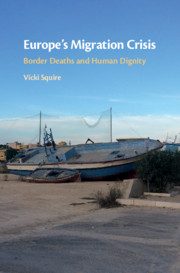Book contents
- Europe’s Migration Crisis
- Europe’s Migration Crisis
- Copyright page
- Contents
- Figures
- Acknowledgements
- Introduction
- Part I The Production of Death and Vulnerability
- Chapter 1 Crisis Politics
- Chapter 2 Biophysical Violence and Ultra-precarity
- Chapter 3 Human Dignity
- Part II The Production of Solidarity and Hope
- Conclusion
- Postscript
- Notes
- Bibliography
- Index
Chapter 2 - Biophysical Violence and Ultra-precarity
The Normalisation of Death and Vulnerability
from Part I - The Production of Death and Vulnerability
Published online by Cambridge University Press: 16 September 2020
- Europe’s Migration Crisis
- Europe’s Migration Crisis
- Copyright page
- Contents
- Figures
- Acknowledgements
- Introduction
- Part I The Production of Death and Vulnerability
- Chapter 1 Crisis Politics
- Chapter 2 Biophysical Violence and Ultra-precarity
- Chapter 3 Human Dignity
- Part II The Production of Solidarity and Hope
- Conclusion
- Postscript
- Notes
- Bibliography
- Index
Summary
Far from a crisis that could not be predicted and that cannot be resolved, the so-called Mediterranean migration crisis of 2015–2016 can be understood as a foreseeable result of the production of death and vulnerability, whereby those who escape across the Mediterranean Sea by boat are either left to perish en route or are rescued only to arrive to EU territory as casualties or survivors. This chapter builds on the analysis in Chapter 1 in order to develop further understanding of this process, specifically by exploring the policy mechanisms and power dynamics through which death and vulnerability are rendered normal (i.e. regular and accepted). It examines policy developments within the EU in terms of different mechanisms of prevention, rescue and containment, to highlight the ways in which instruments that monitor, filter and channel migration expose people on the move to various harms without recourse to rights. Showing how such harms are perpetuated across both the security and humanitarian domains, the chapter draws on works that analyse the co-constitution of border security and humanitarianism to emphasise the ways in which a form of humanitarian government is implicated in a politics that seeks to secure home. However, it also draws attention to the limits of an approach that overlooks the importance of humanitarian politics, which involves more far-reaching contestations over what it means to be human. Highlighting the challenges that are posed to a humanitarian politics where the Mediterranean Sea itself plays a crucial role in practices of governing migration, the chapter concludes by exploring how different dynamics of power become blurred through a form of biophysical violence that operates directly on the biological functions of migrating bodies.
Keywords
- Type
- Chapter
- Information
- Europe's Migration CrisisBorder Deaths and Human Dignity, pp. 43 - 75Publisher: Cambridge University PressPrint publication year: 2020

